Abstract
Calcium yttrium aluminate (CaYAl3O7) crystal was grown and characterized in detail for high temperature piezoelectric sensors for the first time. The thermal properties of the CaYAl3O7 (CYAM) crystal were investigated systematically. In particular, the CYAM crystal exhibits considerably high resistivity along X- and Z- direction in the order of 6.96 × 107 Ω·cm and 2.86 × 108 Ω·cm at 600 °C, respectively. The temperature dependence of the electromechanical properties of CYAM crystal were investigated over the temperature range of 25–500 °C. The high thermal stability of piezoelectric properties together with its high electrical resistivity, makes CaYAl3O7 crystal a promising candidate for high temperature piezoelectric applications.
1. Introduction
Currently, electromechanical devices have been designed and extensively used in various electronic devices such as actuators, sensors, and transducers. Innovations in electromechanical devices continue to be the main driving force for the exploration of novel piezoelectric materials, especially in a high-temperature and harsh environment [1,2,3,4]. Nowadays, from the perspective of practical application, developing lead-free piezoelectric materials with the merits of high electrical resistivity, low dielectric loss, large piezoelectric coefficient and high temperature stability are desirable for wide range of high-temperature sensor applications [5,6,7,8]
Recently, melilite crystals with formula of ABC3O7, which belong to the tetragonal system with space group of P421m, has attracted much attention in high temperature piezoelectric investigations. Here, A = Ca, Sr, Ba; B = La, Gd; and C = Al, Ga, respectively [9,10,11]. In general, the ABC3O7 family presents no phase transition up to their melting point (1500~1700 °C), exhibiting good piezoelectric properties without pyroelectricity [12]. Furthermore, melilite crystals can be grown from melt by Cz technique. As reported, SrGdGa3O7, SrLaGa3O7 and BaLaGa3O7 possess high piezoelectric coefficients (d14 = 14.5, 13.7, 12.3 pC/N, respectively), [9,13], which are much larger than those of quartz (d11 = 2.3 pC/N), GaPO4 (d11 = 4.5 pC/N) and La3Ga5SiO14 (LGS) (d11 = 6.3 pC/N) [14,15,16]. Ca2Al2SiO7, likewise, as a member of the melilite family, exhibits a high resistivity on the order of 107 Ω·cm at 600 °C, which is two orders of magnitude higher than that of LGS crystals, indicating its advantages for high temperature sensors [14,17]. However, up to now, there have been no piezoelectric reports on their homogenous compound CaYAl3O7 crystal, which is therefore the research target of this work.
CaYAl3O7 (abbreviated as CYAM) single crystal, a member of the melilite family, possesses a high melting point of around 1630 °C with no phase transitions below the melting point [18]. In general, in view of the common physical properties, aluminate always possesses higher melting point and larger electrical resistivity than gallium oxide of the same type, which means that CYAM crystal may exhibit better piezoelectric performance and be more competitive for high temperature piezoelectric applications. In recent years, this compound has been studied for long lasting phosphorescence by doping Ce and Eu [19,20]. However, to date, limited investigations have been carried out on the temperature dependence of thermal, piezoelectric and related properties of this crystal. Therefore, it is high time to investigate the potential of CYAM single crystal as a new candidate for high temperature piezoelectric applications.
In this work, the thermal expansion and thermal conductivity were systematically investigated at elevated temperatures for piezoelectric sensing applications. Furthermore, the temperature dependence of the electrical resistivity, dielectric, piezoelectric, elastic constants and electromechanical coupling coefficient were investigated in the range of 25–500 °C.
2. Experimental
The crystals were grown by the Czochralski (Cz) technique using an automatic diameter control system with an RF induction heater. The synthesized polycrystalline materials were melted in an iridium crucible of Φ60 × 50 mm3 dimensions. Single crystals were grown with the <001> oriented seed crystals under Ar atmosphere. The pulling speed and rotation rate were set to be 0.6–1 mm/h and 15–25 rpm, respectively. After the growth process, the as grown crystals were cooled down to room temperature at a rate of 40~50 °C h−1.
For micro-hardness measurement, a DHV-1000 digital micro tester (Shanghai Precision Instruments Co., Ltd., Shanghai, China) equipped with a diamond pyramidal indentor was employed. Polished wafers with dimensions of 4 × 4 × 1 mm3 were used for the measurements. The indentation load was stressed at a value of 50 g and the selected time was 10 s. Three test points were performed per sample to obtain the average value. The microhardness (Hv) and Mohs hardness (HM) values were calculated using the following equations [21]:
where P is the applied load pressure and d is the diagonal length of the indentations.
The density of the CYAM crystal was measured by the Archimedes method and calculated according to the following equation:
where m0 is the sample weight in air, m1 is the sample weight immersed completely in distilled water, and water is the density of the distilled water at the measurement temperature (25 °C). Each density was determined by averaging the values of three samples in this experiment.
The linear thermal expansion coefficients of CYAM crystal were measured by a thermal mechanical analyzer (Mettler-Toledo Company, Zurich, Switzerland) in the temperature range of 25–500 °C. A cube crystal sample of 4 × 4 × 4 mm3 (a × a × c) was prepared from the as-grown crystals for the thermal expansion measurements.
The Perkin Elmer Diamond differential scanning calorimetry (Diamond DSC-ZC, Waltham, MA, USA) method was employed to determine the specific heat using a simultaneou thermal analyzer. The measurement temperature and heating rate were from 25 to 500 °C and 5 °C min−1 respectively. The thermal diffusivity was performed by a Netzsch Nanoflash model LFA 457 apparatus (Netzsch, Selb, Germany). Sample plates of (001) and (100) plates with the dimensions of 4 × 4 × 1 mm3 were cut from the as-grown crystal. The samples were coated with graphite on both the 4 × 4 mm2 faces for even heating. When a short pulse heats one side of the sample, the temperature on the opposite surface is measured with an IR detector, from which the diffusivity coefficient is calculated. The temperature range is from 25 to 500 °C.
The electrical resistivity of X- and Z-direction was determined from the resistance, which was measured using a 2410 High-Voltage SourceMeter (Keithley, Cleveland, OH, USA) by applying 100 V on the two samples.
Belonging to the tetragonal space group P421m, CYAM crystal possesses 10 independent electro-elastic constants: two dielectric constants (ε11 and ε33), six elastic constants (s11, s12, s13, s33, s55, and s66), and two piezoelectric constants (d14 and d36).
Six CYAM crystal samples were prepared according to the Institute of Electrical and Electronics Engineers (IEEE) standard on piezoelectricity [22]. Table 1 lists the specimen orientations and shapes for the corresponding elastic and piezoelectric coefficients and the effective electromechanical coupling factors.

Table 1.
Effective elastic and piezoelectric constants for different specimens.
The capacitance of X- and Z-cut square plates at 1 kHz, as well as the resonance (fr) and antiresonance (fa) frequencies were measured using an Agilent 4294A type LCR (Agilent, CA, USA). Based on the measured capacitance, fa and fr values, the complete sets of dielectric, elastic and piezoelectric coefficients for the CYAM crystal were calculated. Additionally, the first, second, and third order temperature coefficients of the elastic compliance constants were calculated according to the following equations [22,23]:
where sij0 is the elastic coefficient at the temperature T = T0.
3. Results and Discussion
As is shown in Table 2, the Hv hardness values of the <100> and <001> oriented samples for the CaYAl3O7 crystal were found to be 1188 and 833 kg mm−2, respectively, with the Mohs hardness values being on the order of 7.14 and 6.35, respectively. By comparison, the <100> oriented hardness values are larger than the <001> oriented one. This phenomenon is contributed to the anisotropic effects of crystal. The atomic arrangement inside the sheet layer (<100> direction) is much closer than that along the <001>-direction, therefore, stronger interatomic forces are associated with a larger hardness.

Table 2.
Microhardness (Hv) hardness and Mohs hardness.
The density of CaYAl3O7 at room temperature measured by the Archimedes method was found to be 3.61 ± 0.01 g/cm3, which is consistent with the calculated value based on XRD results, namely, 3.60 g/cm3.The density values at different temperatures were calculated based on the thermal expansion coefficients according to the following formula:
where ρ0 is the density at room temperature, the value of ∆a/a = ∆b/b and ∆c/c can be obtained from the corresponding thermal expansion curves, as illustrated in Figure 1, the density of crystal decreases linearly from 3.61 to 3.54 g/cm3 over the range of 25–500 °C.
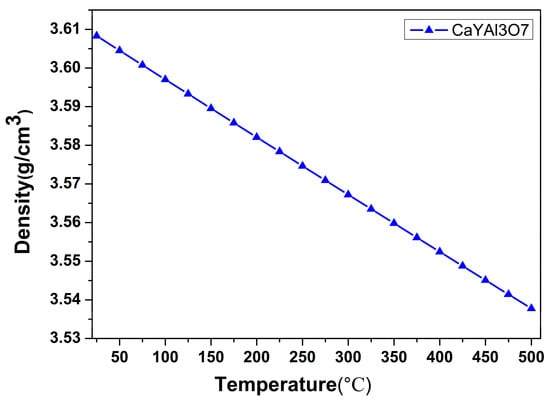
Figure 1.
Density as a function of temperature for CaYAl3O7 (CYAM) crystal.
The thermal expansion coefficient αij of a crystal is a symmetric second-rank tensor. As the CaYAl3O7 crystal has a tetragonal system, there are two independent thermal expansion coefficients, α11 and α33 (α11 = αa, α33 = αc). The average thermal expansion coefficient can be calculated according to the following equation [24]:
where is the average thermal expansion coefficient over the temperature range from T0 to T, L0 is the sample length at T0, ΔL is the length exchange when the temperature changes from T0 to T, and ΔT = (T − T0) is the temperature exchange value. As can be seen from Figure 2, these two thermal expansion curves are increased linearly without any significant deviation within the measuring temperature range from 25 °C to 500 °C. The linear thermal expansion coefficients were calculated to be: αa = 6.63 × 10−6 K−1 and αc = 28.52 × 10−6 K−1, where the αc is much higher than that of αa, due to the fact that the weak Ca-O and Y-O bonds along the Z direction contribute greatly to the thermal expansion, while inside the XY-plane, strong interatomic forces result in a lower thermal expansion [19].
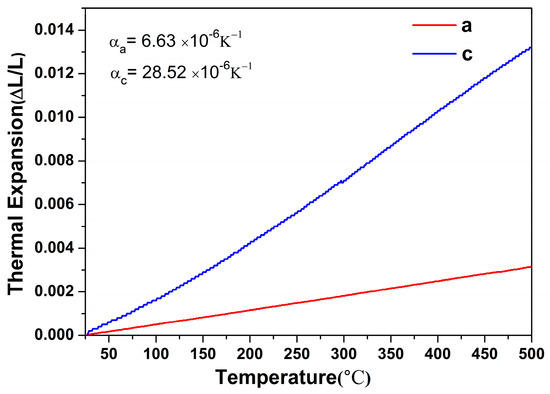
Figure 2.
The thermal expansion of CYAM crystal along a and c axes.
Based on the thermal diffusivity and specific heat, the thermal conductivity can be calculated by using the equation k = λ·ρ·Cp, where λ, ρ, Cp denote the thermal diffusion coefficient, density and specific heat, respectively. The thermal conductivity of CYAM crystal was calculated as a function of temperature and depicted in Figure 3. The thermal conductivities of CaYAl3O7 along the a and c direction at room temperature were 1.82 and 1.37 W·m−1·K−1 respectively. As can be seen, the thermal conductivity increases with increasing temperature. This phenomenon indicates that the CYAM crystal can tolerate more thermal load at high temperature.
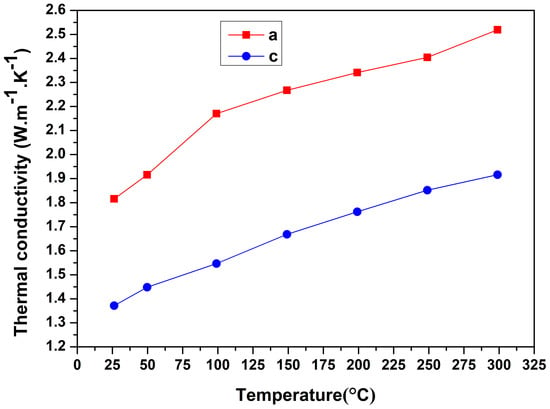
Figure 3.
The thermal conductivity of CYAM crystal along a and c axes.
High resistivity at high temperature is beneficial to reduce the electrical losses and to improve the signal/noise ratio of sensors. Figure 4 gives the anisotropy of electrical resistivity and the temperature-dependent behaviors of electrical resistivity for CYAM crystal. In general, the resistivity decreases exponentially with the increase of temperature, as seen in the linear character of the curves in the Arrhenius plot, which is expressed by the Arrhenius law as follows:
where ρ0 is the ultimate resistivity at an infinite temperature, kB is the Boltzmann constant, T is the absolute temperature, and Ea is the activation energy, which can be determined from the logarithm plot of ρ vs. reciprocal temperature 1000/T, reflects the slope of the curves. The calculated Ea values of the CYAM crystal along X- and Z- direction are 1.11 and 1.10 eV, respectively. As can be seen, the resistivity along Z-direction is an order of magnitude larger than the value along X-direction, due to the AlO4 layered crystal structure, where the layers are linked by high density interconnected antiprisms vertical to the Z-direction, giving rise to higher conductivity along the X-direction than that along the Z-direction [19]. In particular, the electrical resistivity along the X-axis and Z-axis were found to be 6.96 × 107 Ω·cm and 2.86 × 108 Ω·cm at 600 °C, respectively, which are comparable to Ca2Al2SiO7 (108 Ω·cm at 600), and which are much larger than those of LiNO3 crystals (1.2 × 105 Ω·cm) and LGS (2.5 × 105 Ω·cm) at the same temperature. This demonstrates the advantages of CYAM crystal for high temperature piezoelectric applications.
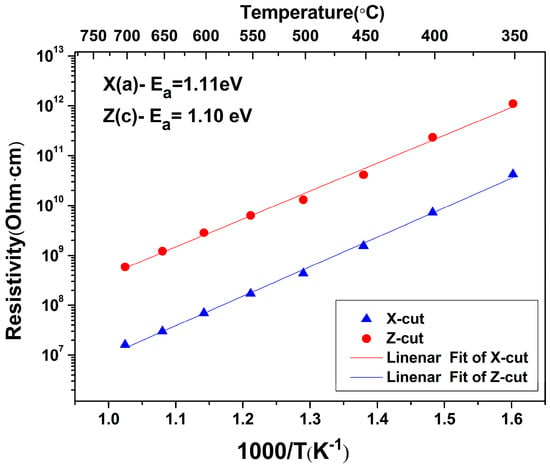
Figure 4.
Temperature dependence of the resistivity of grown CYAM crystal.
In order to characterize the temperature stability of CYAM piezoelectric crystal, temperature dependence of the dielectric and electro-elastic constants was investigated systematically.
The temperature dependence of the dielectric constant (εij/ε0) and dielectric loss (tan δ) at 1 kHz as a function of temperature for CYAM crystal along the X- and Z- axes is depicted in Figure 5. As can be seen, the dielectric permittivity values ε11/ε0 and ε33/ε0 were found to increase slightly with increasing temperature, and the corresponding dielectric loss (shown in the Figure 5) is steady around 1% from room temperature to 450 °C, and then it increases rapidly to ~2.5% at 500 °C.
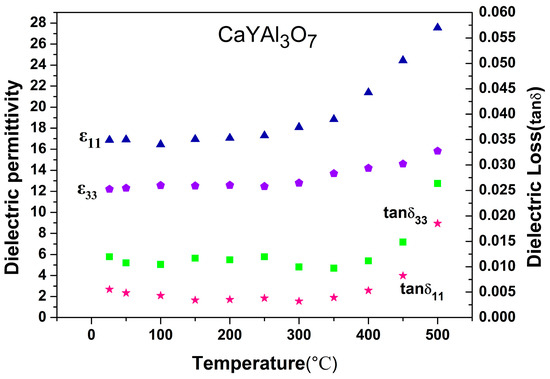
Figure 5.
Dielectric permittivity and dielectric loss (tan δ) of CYAM crystal as a function of temperature.
Understanding of the temperature dependence of the elastic constants is also quite important for the application of crystals. The temperature dependent elastic compliance sij of CYAM crystals is shown in Figure 6. With an increase in temperature, the values of sij exhibit a very stable state in the temperature range of 25~500 °C. It is concluded that the crystal exhibits high thermal stability of elastic constant with variation less than 4%. As can be seen from Table 3, the first-, second-, and third-order temperature coefficients of the elastic coefficients have been shown by using equations below, indicating that CYAM has superior temperature stability.
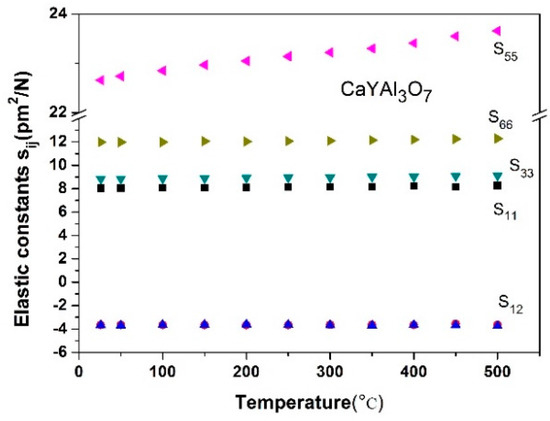
Figure 6.
Temperature dependence of the elastic compliance of CYAM crystal.

Table 3.
First-, Second-, and Third-Order Temperature Coefficients of the Elastic Constants.
Figure 7 shows the piezoelectric coefficient variation as a function of temperature. The piezoelectric coefficients of d36 maintained similar values in the range of 25~500 °C, while d14 increased slightly from 12.56 to 14.94 pC/N over the temperature range of 25~500 °C, with the variations being less than 19%.
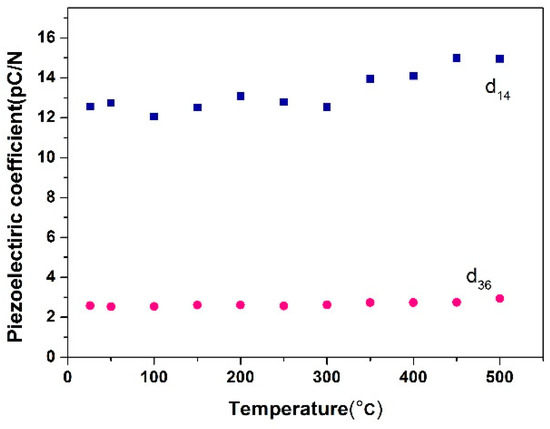
Figure 7.
Temperature dependent piezoelectric coefficient of CYAM crystal.
The temperature dependence of the electromechanical coupling factors k14 and k36 was also measured, as shown in Figure 8. The electromechanical coupling k14 and k36 were found to be 18.28% and 5.36% at 500 °C, respectively. As expected, the variation tendency of the coupling factors is similar to that of the piezoelectric coefficients, increasing slightly with increasing temperature with total variation of less than 4%.
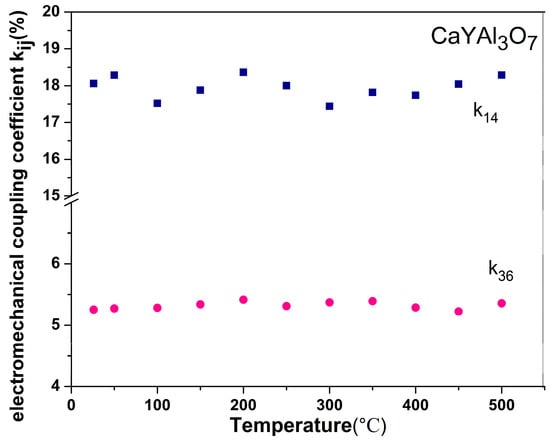
Figure 8.
Electromechanical coupling factor of CYAM crystal as a function of temperature.
4. Conclusions
In summary, the temperature dependence of electrical resistivity, dielectric and piezoelectric, elastic properties of CaYAl3O7 crystal are reported. The fundamental properties, including hardness, density and thermal properties have also been systematically measured. The density was measured to be 3.61 g/cm3, which was in good agreement with the theoretical value. The thermal expansion coefficients were calculated to be αa = 6.63 × 10−6 K−1 and αc = 28.52 × 10−6 K−1. It is notable that the electrical resistivity for CYAM crystal was over 107 Ω·cm along both the X- and Z directions at 600 °C, which are much larger than those of LiNO3 crystals (1.2 × 105 Ω·cm) and LGS (2.5 × 105 Ω·cm). This investigation concerning the temperature dependence in respects of the dielectric, elastic and piezoelectric properties of CYAM crystal shows an excellent thermal stability. Based on the high temperature stability of its resistivity and piezoelectric properties, together with the high melting point (~1630 °C), CaYAl3O7 single crystal is an excellent candidate for piezoelectric sensors.
Acknowledgments
We gratefully acknowledge the financial support from the National Natural Science Foundation of China (Grant No. 51321091, 51772170 and 51323002) and the Young Scholars Program of Shandong University (Grant No. 2015WLJH36).
Author Contributions
Xiaoqiang Yu and Xutang Tao conceived and designed the experiments. Qiangqiang Hu and Yang Li performed the growth of the single crystal; Wenxiang Mu performed the thermal experiments and analyzed the data. Yang Li and Yanru Yin accomplished the electrical resistivity and high temperature piezoelectric measurements; Jian Zhang collected the single-crystal X-ray diffraction data and solved the structures; Zhitai Jia and Yang Li wrote the paper.
Conflicts of Interest
The authors declare no conflict of interest.
References
- Zhang, S.; Yu, F.; Green, D.J. Piezoelectric materials for high temperature sensors. J. Am. Ceram. Soc. 2011, 94, 3153–3170. [Google Scholar] [CrossRef]
- Zhang, S.; Zheng, Y.; Kong, H.; Xin, J.; Frantz, E.; Shrout, T.R. Characterization of high temperature piezoelectric crystals with an ordered langasite structure. J. Appl. Phys. 2009, 105, 114107. [Google Scholar] [CrossRef]
- Shrout, T.R.; Zhang, S.J. Lead-free piezoelectric ceramics: Alternatives for PZT? J. Electroceram. 2007, 19, 113–126. [Google Scholar] [CrossRef]
- Fu, H.; Cohen, R.E. Polarization rotation mechanism for ultrahigh electromechanical response in single-crystal piezoelectrics. Nature 2000, 403, 281. [Google Scholar] [CrossRef] [PubMed]
- Zhang, S.-T.; Kounga, A.B.; Aulbach, E.; Deng, Y. Temperature-dependent electrical properties of 0.94Bi0.5Na0.5TiO3–0.06BaTiO3 ceramics. J. Am. Ceram. Soc. 2008, 91, 3950–3954. [Google Scholar] [CrossRef]
- Baba, A.; Searfass, C.T.; Tittmann, B.R. High temperature ultrasonic transducer up to 1000 °C using lithium niobate single crystal. Appl. Phys. Lett. 2010, 97, 232901. [Google Scholar]
- Turner, R.C.; Fuierer, P.A.; Newnham, R.E.; Shrout, T.R. Materials for high temperature acoustic and vibration sensors: A review. Appl. Acoust. 1994, 41, 299–324. [Google Scholar] [CrossRef]
- Fritze, H.; Tuller, H.L. Langasite for high-temperature bulk acoustic wave applications. Appl. Phys. Lett. 2001, 78, 976–977. [Google Scholar] [CrossRef]
- Shen, C.; Zhang, Y.; Yu, H.; Zhang, S.; Cao, W.; Wang, J.; Zhang, H. Dielectric, elastic and piezoelectric properties of SrLaGa3O7 and BaLaGa3O7 crystals with melilite structure. J. Alloys Compd. 2015, 647, 1069–1074. [Google Scholar] [CrossRef]
- Smith, R.T.; Welsh, F.S. Temperature dependence of the elastic, piezoelectric, and dielectric constants of lithium tantalate and lithium niobate. J. Appl. Phys. 1971, 42, 2219–2230. [Google Scholar] [CrossRef]
- Xia, H.; Feng, J.; Wang, Y.; Li, J.; Ji, Y.; Jia, Z.; Tu, C. The effects of Ho3+ and Pr3+ ions on the spectroscopic properties of Er3+ doped SrGdGa3O7 crystals used in mid-infrared lasers. J. Phys. D Appl. Phys. 2015, 48, 435106. [Google Scholar] [CrossRef]
- Shen, C.; Zhang, S.; Wang, D.; Xu, T.; Yu, H.; Cao, W.; Wang, J.; Zhang, H. Growth and property characterization of CaNdGa3O7 and SrNdGa3O7 melilite single crystals. CrystEngComm 2015, 17, 1791–1799. [Google Scholar] [CrossRef]
- Zhang, Y.; Yin, X.; Yu, H.; Cong, H.; Zhang, H.; Wang, J.; Boughton, R.I. Growth and piezoelectric properties of melilite ABC3O7 crystals. Cryst. Growth Des. 2012, 12, 622–628. [Google Scholar] [CrossRef]
- Shimamura, K.; Takeda, H.; Kohno, T.; Fukuda, T. Growth and characterization of lanthanum gallium silicate La3Ga5SiO14 single crystals for piezoelectric applications. J. Crys. Growth 1996, 163, 388–392. [Google Scholar] [CrossRef]
- Philippot, E.; Ibanez, A.; Goiffon, A.; Cochez, M.; Zarka, A.; Capelle, B.; Schwartzel, J.; Détaint, J. A quartz-like material: Gallium phosphate (GaPo4); crystal growth and characterization. J. Cryst. Growth 1993, 130, 195–208. [Google Scholar] [CrossRef]
- Tichý, J.; Privatska, J.; Prívratská, J.; Kittinger, E.; Erhart, J.; Janovec, V. Fundamentals of piezoelectric sensorics : Mechanical, dielectric, and thermodynamical properties of piezoelectric materials. Cheminform 2010, 34, 1423–1440. [Google Scholar]
- Hagiwara, M.; Noguchi, H.; Hoshina, T.; Takeda, H.; Fujihara, S.; Kodama, N.; Tsurumi, T. Growth and characterization of Ca2Al2SiO7 piezoelectric single crystals for high-temperature sensor applications. Jpn. J. Appl. Phys. 2013, 52, 09KD03. [Google Scholar] [CrossRef]
- Philippen, J.; Guguschev, C.; Klimm, D. Single crystal fiber growth of cerium doped strontium yttrate, SrY2O4:Ce3+. J. Cryst. Growth 2017, 459, 17–22. [Google Scholar] [CrossRef]
- Park, S.H.; Lee, K.H.; Unithrattil, S.; Yoon, H.S.; Jang, H.G.; Im, W.B. Melilite-structure CaYAl3O7:Eu3+ phosphor: Structural and optical characteristics for near-UV led-based white light. J. Phys. Chem. C Nanomater. Interfaces 2012, 116, 26850–26856. [Google Scholar] [CrossRef]
- Kodama, N.; Takahashi, T.; Yamaga, M.; Tanii, Y.; Qiu, J.; Hirao, K. Long-lasting phosphorescence in Ce3+-doped Ca2Al2SiO7 and CaYAl3O7 crystals. Appl. Phys. Lett. 1999, 75, 1715–1717. [Google Scholar] [CrossRef]
- Yuan, D.; Jia, Z.; Wang, J.; Gao, Z.; Zhang, J.; Fu, X.; Shu, J.; Yin, Y.; Hu, Q.; Tao, X. Bulk growth, structure, and characterization of the new monoclinic TbCa4O(BO3)3 crystal. CrystEngComm 2014, 16, 4008–4015. [Google Scholar] [CrossRef]
- Meitzler, A.H.; Berlincourt, D.; Welsh, F.S.; Tiersten, H.F.; Coquin, G.A.; Warner, A.W. 176-1987 IEEE Standard on Piezoelectricity; IEEE: Piscataway, NJ, USA, 1988. [Google Scholar]
- Gao, Z.; Yin, X.; Zhang, W.; Wang, S.; Jiang, M.; Tao, X. Temperature dependence of elastic properties and piezoelectric applications of BaTeMo2O9 single crystal. IEEE Trans. Ultrason. Ferroelectr. Freq. Control 2011, 58, 2753. [Google Scholar] [CrossRef] [PubMed]
- Hu, Q.; Jia, Z.; Tang, C.; Lin, N.; Zhang, J.; Jia, N.; Wang, S.; Zhao, X.; Tao, X. The origin of coloration of CaGdAlO4 crystals and its effect on their physical properties. CrystEngComm 2017, 19, 537–545. [Google Scholar] [CrossRef]
© 2018 by the authors. Licensee MDPI, Basel, Switzerland. This article is an open access article distributed under the terms and conditions of the Creative Commons Attribution (CC BY) license (http://creativecommons.org/licenses/by/4.0/).